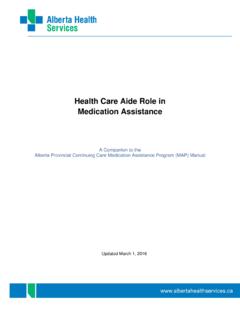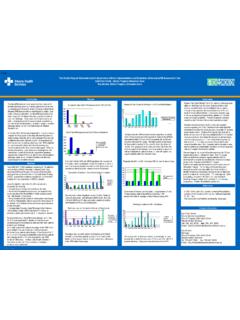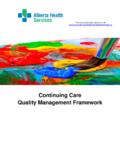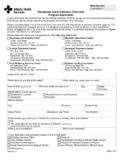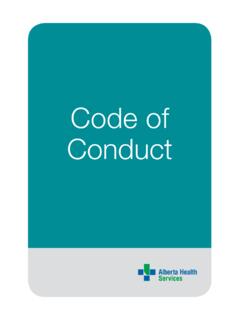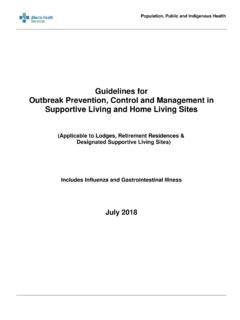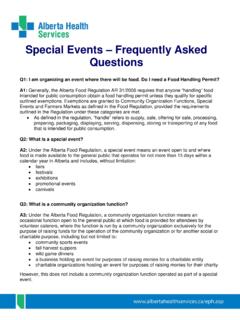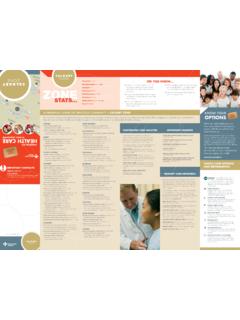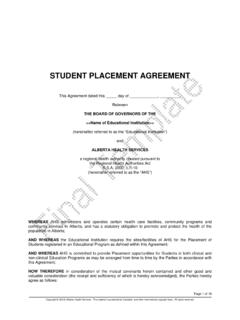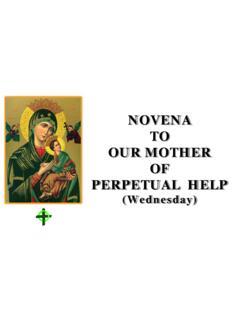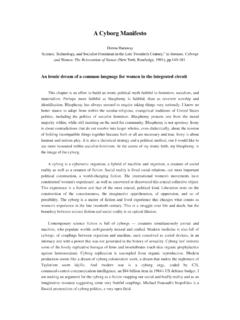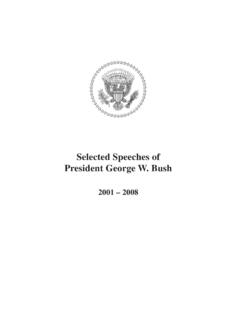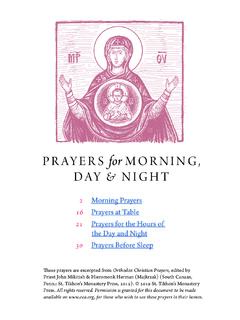Transcription of Health Care and Religious Beliefs Booklet
1 Health care and Religious Beliefs Second Edition Health care and Religious Beliefs Table of Contents Foreword .. 4. Aboriginal faith community .. 6. Buddhist faith community .. 9. Christian Science faith community .. 12. Church of Jesus Christ of Latter-day Saints faith community .. 14. Eastern Orthodox faith community .. 16. Hindu faith community .. 18. Islamic faith community .. 20. Jehovah's Witness faith community .. 24. Jewish faith community .. 25. Protestant faith community .. 28. Roman Catholic faith community .. 29. Seventh-day Adventist faith community .. 31. Sikh faith community .. 33. United Church faith community .. 37. Ideas for multicultural, multifaith care .. 40. Spiritual care assessment tool .. 42. Footnotes .. 43. Bibliography .. 44. Special thanks .. 45. 1. Health care and Religious Beliefs Foreword The current medical model in Health and wellness acknowledges the treatment of an individual as a whole with a need to treat the bio/psycho/.
2 Social aspects of Health . A growing realization in Health care is that this model also must acknowledge the spiritual Health of an individual in order to maximize the healing and recovery process. Alberta Health Services' Spiritual care Advisory Committee in Calgary was created as recognition of this need. As a group of interfaith community representatives, we meet with Spiritual care Services to provide advice for patients' spiritual care . Due to the ethnic and Religious diversity reflected in the expanding population of Calgary and area, there is an ever-growing need for frontline Health - care professionals to address the spiritual needs and requirements of their patients. The Spiritual care Advisory Committee has noted the lack of resources for Health - care professionals in this area. In an effort to deal with this issue, the committee has surveyed frontline Health care workers regarding acute patient care . The unanimous request was for a concise and clear resource that highlights the most pertinent issues of a patient's spiritual and Religious care .
3 Based on the results of the survey, the project of creating a resource was born. In our search for other similar resources, we came across the Booklet Health care and Religious Beliefs by Loma Linda University Medical Center. They have graciously allowed us to utilize information from their Booklet and, as such, some portions (in whole or in part) have been used. With the co-operation and hard work of every member of the Spiritual care Advisory Committee, we have completed this resource. As a committee we hope this Booklet will help Health - care professionals provide spiritual care that is both nurturing and respectful to all patients, given the diversity of Religious backgrounds represented. 2. Health care and Religious Beliefs I wish to thank the Spiritual care Advisory Committee for its participation in creating the first edition of this Booklet . I would also like to thank Sue Ramsden (Social Work and Spiritual care ). Her collaboration was critical in every aspect of development, production and completion of the first edition of this project.
4 Since the release of the first edition in 2011, we have received many requests from hospitals in the United States as well as organizations in Canada to utilize our Booklet as a resource. Please note that in this second edition, there have been amendments and additions by various contributing Religious communities. I would like to acknowledge Conny Betuzzi, Manager, Patient care of Allied Health for her assistance during the completion of this second edition. Dr. Harjot K. Singh Chair Spiritual care Advisory Committee Alberta Health Services - Calgary June 2015. 3. Health care and Religious Beliefs Caring and sharing are ABORIGINAL markers of positive relationships. FAITH COMMUNITY. Holistic view or understanding that all things are inter- connected, inter-dependent Beliefs and cyclical by nature ( , The Medicine Wheel or Circle Aboriginal peoples of Canada do of Life; childhood, youth, not comprise a single monolithic adult, elder, individual, family, cultural group but are represented community, nation; mental, by over 50 cultural language emotional, physical, spiritual.)
5 Groups within Canada. Canada's east, south, west, north; spring, Aboriginal peoples are comprised summer, fall, winter, etc.). of First Nations, Inuit, and M tis. Value of the individual, family Although much diversity exists (extended relatives such as between Aboriginal Peoples in uncles, aunts, cousins are both the content and interpretation commonly considered as of worldview and philosophical fathers, mothers, brothers, thought, it is generally accepted sisters), community (older the following comprise common community members Elders'. elements: are commonly considered as grandfathers and belief in one all-encompassing grandmothers), and nation. Creator. An ethic of non-interference The Seven Sacred Laws or permeates social interactions. Teachings of Love, Respect Consensus ( , family/. Courage, Honesty, Wisdom, community) decision-making Humility, and Truth form the is common. foundation of a healthy way of life by honoring ourselves, The four seasons based on the others, and Mother Earth.
6 A lunar calendar ( Winter value of honor and respect for Solstice Dec 21st, Spring all of life is encouraged and Equinox, Summer Solstice aimed for. June 21st, and Fall Equinox). are important days/seasonal markers for Aboriginal 4. Health care and Religious Beliefs people and are celebrated and (For more information see: Kim observed by smudging, sweats, ma pii pi tsi Caring for Life.. pipe ceremonies, feasts and Aboriginal Health Program, 2007. drumming circles, etc. - 2014).Web Site: http://www. Aboriginal people do not have aboriginal/ any sacred texts or writings;. spiritual knowledge and wisdom, or spirituality, is Death and Grief based on oral tradition passed down orally through the For Aboriginal people, death is a teachings of Elders. part of the cycle of life. Overview of The person who dies has completed The Circle of Life - a Health and illness continuum of life through which a person transitions from childhood For Aboriginal people Health to youth, from adulthood to Elder holistic and is represented by status - and begins the journey to balance in all aspects of life the Land of Souls' or is reunited (physical, mental, emotional, with the Grandfathers and spiritual) based on the teachings of Grandmothers' in the afterlife.
7 The Medicine Wheel. There is no elaborate or Aboriginal traditional approaches extensive theology or philosophy of to Health and wellness include death among traditional Aboriginal the use of sacred herbs (sweet people. Prayers before and after the grass, sage, cedar, tobacco, etc.), time of death are usually conducted traditional healers/medicine people by an Elder who will ceremonially (herbal medicine), and elders who smudge' ( , burning of sweet are recognized, respected, and grass, sage, cedar, etc.) the body as utilized as an integral part of the a form of purification or cleansing healing journey. to prepare the soul for its spiritual journey (for some Aboriginal Western medicine and traditional people the journey takes four days'). healing practices are both embraced as enhancing and complementing At the time of death, there will healing. usually be a large gathering of immediate and extended family 5. Health care and Religious Beliefs members because it is their familial to remember their loved one and duty to be present at the time of to mark or signal the end of their death to provide support to the mourning to the community.
8 Bereaved family. Because of the diversity that Also, family will usually spend exists among Aboriginal people time with the body and sometimes mourning traditions vary from assigned family members (usually community to community. women) will ceremonially wash the body as a sign of affection and Diet respect and as preparation for burial. Generally, Aboriginal people The family or community will do not have any Religious /cultural usually conduct a one or two day dietary restrictions. wake of reminiscing and story- telling (humor or laughter is quite common) to remember and honor Do's and Don'ts the deceased person and then conduct a burial of the body on the Sacred Ceremonial articles or fourth day. objects (such as sweetgrass, sage, cedar, tobacco; medicine Traditional burial is more pouches/bags; pipes; traditional commonly practiced than cremation, blankets, etc.) are not to be but cremation is not excluded. handled without permission. Include the immediate Decisions about autopsy are family in medical treatment usually not an issue, if medically decision-making.
9 Or legally required (for still births, if possible, some Aboriginal Interpreters may be needed for families' communities traditionally elderly patients whose only bury, on the same day, the fetus/ language is their mother tongue. baby before sundown). Recognition and respect of Aboriginal Elders as spiritual A feast will be served to the whole leaders representing their community on the day of the burial. communities as traditional ceremonialists/healers. The family will mourn for one year and then host a memorial feast 6. Health care and Religious Beliefs Accommodate spiritual Medical Treatment practices such as smudging ceremonies ( , burning of Generally, most medical sweetgrass) for patients with treatment is acceptable to limited mobility or who are Aboriginal people. critically ill or dying. Organ donation or harvesting Respect for, and inclusion of, of organs ( , clinically dead if possible, traditional herbal patient) is generally not an medicine with western medical option for Aboriginal families treatment in collaboration because they view it as a withpatients, families, desecration of the body.
10 There and physicians. are, of course, exceptions. Abortion is generally not Organ donation of a living acceptable unless the life donor is generally acceptable of the mother is at stake and is usually an individual/. (individual/family decision). family medical decision ( , Preventative birth control is a consensus decision-making). personal decision. Organ transplantation is If uncertain of Aboriginal generally acceptable and cultural/spiritual Beliefs or is usually an individual/. practices it is acceptable to family medical decision ( , humbly and respectfully ask consensus decision-making). for guidance. Also, recognize that because of Canada's colonial history and the influence of Christianity blended Religious /. spiritual traditions exist among Aboriginal people. 7. Health care and Religious Beliefs 1) Accepting the Four Noble BUDDHIST Truths. FAITH COMMUNITY 2) Developing a deep awareness and understanding of the impermanence and inherent dissatisfaction of Beliefs sense pleasure.
